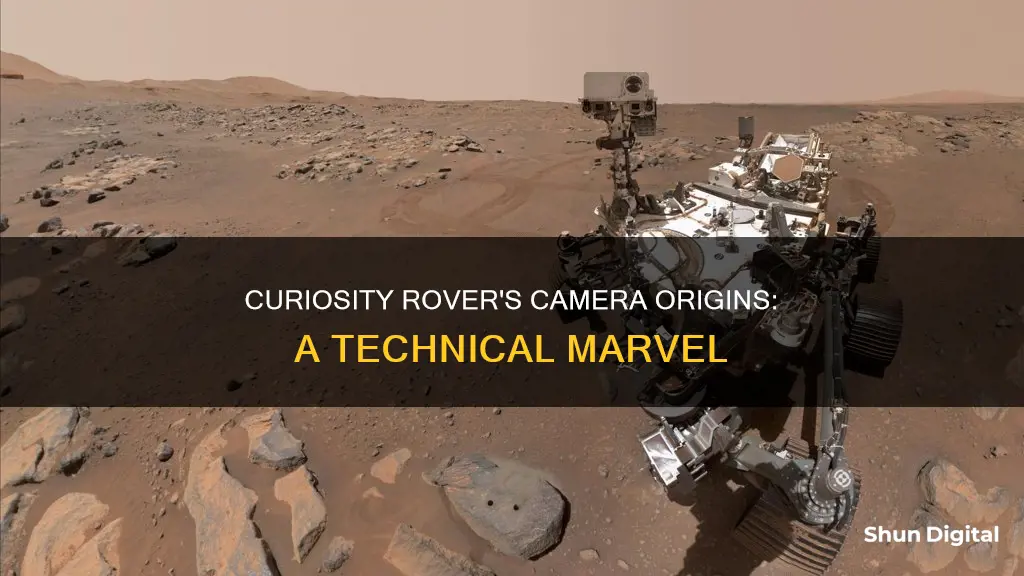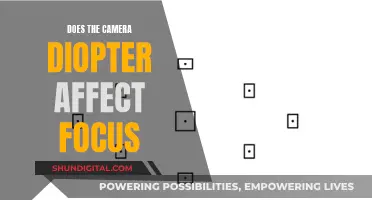
The Curiosity rover, which landed on Mars in 2012, has 17 cameras in total. These include the Mars Descent Imager (MARDI), the Mars Hand Lens Imager (MAHLI), the MastCams, the Navigation Cameras (NavCams), and the Hazard Avoidance Cameras (HazCams). The Mast Camera (MastCam) system, which provides multiple spectra and true-colour imaging, was developed by Malin Space Science Systems.
| Characteristics | Values |
|---|---|
| Number of Cameras | 17 |
| Camera Types | Mast Camera (MastCam), Mars Hand Lens Imager (MAHLI), Mars Descent Imager (MARDI), Navigation Cameras (NavCams), Hazard Cameras (HazCams), Remote Micro Imager |
| Camera Functions | Taking images and videos of the Martian landscape, assisting in navigation and hazard avoidance |
| Image Type | Black-and-white, colour, 3D stereo |
| Image Resolution | 1600 x 1200 pixels |
| Video Resolution | 720p |
| Camera Placement | Mast, robotic arm, front and rear of the rover |
What You'll Learn

The Mars Descent Imager (MARDI) camera
MARDI's primary objectives are to determine the exact landing location of the MSL vehicle and to provide a geological and engineering-geological framework of the landing site for early operations. The camera will take about four frames per second at nearly 1,600 by 1,200 pixels per frame for about the final two minutes before the Curiosity rover touches down on Mars. This will result in hundreds of images at scales much larger than those available from orbit.
The camera has an 8-gigabyte internal buffer, allowing it to store over 4,000 raw frames or 800 seconds of video. The images will be used to create a high-definition video of the rover's descent to Mars. This video will be crucial in helping the MSL science team understand the precise location of the rover and its distance from key geological features of interest.
MARDI was supplied by Malin Space Science Systems in San Diego, California.
Uncover the Brand Behind Wall Charger Spy Cameras
You may want to see also

The Mars Hand Lens Imager (MAHLI) camera
The Mars Hand Lens Imager (MAHLI) is a 2-megapixel focusable colour camera located on the turret at the end of the MSL robotic arm. It is the rover's version of the magnifying hand lens that geologists usually carry with them into the field. MAHLI's microscopic images reveal the minerals, textures, and structures in rocks and soil at scales smaller than the diameter of a human hair.
MAHLI acquires images of up to 1600 x 1200 pixels with a colour quality equivalent to that of consumer digital cameras. It has an 18.3 to 21.3 mm focal length and a 33.8–38.5° field of view. The camera can focus on objects as close as 18.3 mm at the closest working distance to 21.3 mm at infinity. MAHLI has both white and ultraviolet light-emitting diode (LED) illumination for imaging in darkness or fluorescence imaging. The ultraviolet light can be used to induce fluorescence to help detect carbonate and evaporite minerals, indicating that water helped shape the landscape on Mars.
MAHLI's main objective is to help the Mars Science Laboratory science team understand the geologic history of the landing site on Mars. It also helps researchers select samples for further investigation and document activities done by other instruments. MAHLI is used to acquire the popular "rover selfies" and to check the health and safety of the rover, such as imaging the wear and tear on the wheels.
Polaroid 600 Camera: Battery Placement Guide
You may want to see also

The Mast Camera (MastCam) system
The Curiosity rover's Mast Camera (MastCam) system is a two-instrument suite of imaging systems mounted on the MSL rover's Remote Sensing Mast (RSM). The MastCam can be used to study the Martian landscape, rocks, and soils; to view weather phenomena; and to support the driving and sampling operations of the rover. The camera is about 6.5 feet (2.0 meters) above ground, or about human-eye height.
The MastCam system provides multiple spectra and true-color imaging with two cameras. The cameras can take true-color images at 1600×1200 pixels and up to 10 frames per second hardware-compressed video at 720p (1280×720). The MastCam can take high-definition video at 10 frames per second and its 8-gigabyte memory allows it to store several hours of HD video or 5,500+ raw frames. The cameras have an autofocus capability that allows them to focus on objects from 2.1 m (6 ft 11 in) to infinity.
One MastCam camera is the Medium Angle Camera (MAC), which has a 34 mm (1.3 in) focal length, a 15° field of view, and can yield 22 cm/pixel (8.7 in/pixel) scale at 1 km (0.62 mi). The other camera in the MastCam system is the Narrow Angle Camera (NAC), which has a 100 mm (3.9 in) focal length, a 5.1° field of view, and can yield 7.4 cm/pixel (2.9 in/pixel) scale at 1 km (0.62 mi).
The MastCam was developed by Malin Space Science Systems in San Diego, California.
Selfie Mode: Why Your Camera is Stuck and How to Fix It
You may want to see also

The Navigation Cameras (NavCams)
The Curiosity rover has a total of 17 cameras, including four black-and-white Navigation Cameras (NavCams) that are placed on the mast of the rover. NavCams are "engineering cameras" that help humans on Earth "see" and drive the rover across the challenging Martian terrain. They are placed on the rover's "head" to provide a long-distance view.
The NavCams have a 45-degree angle of view and use visible light to capture stereoscopic 3-D imagery. With a fixed-aperture f/12 focus, the NavCams capture 45-degree square images. The cameras have a resolution of about 8 feet per pixel.
The NavCams, along with the Hazard Cameras (HazCams), capture images in black and white or greyscale because that is all the rover needs to detect rocks and other obstacles.
Unsticking Camera Battery Acid: A Step-by-Step Guide
You may want to see also

The Hazard Avoidance Cameras (HazCams)
The Curiosity rover is equipped with Hazard Avoidance Cameras (HazCams) to ensure it doesn't collide with obstacles. There are four pairs of these cameras, with two pairs at the front and two at the back of the rover. Each camera in a pair is hardlinked to one of the two main computers for redundancy, and only four out of the eight cameras are in use at any one time. The HazCams are black and white cameras that capture stereoscopic three-dimensional (3D) images using visible light. They have a wide field of view of approximately 120 degrees, which allows them to map the terrain in front of and behind the rover.
The images captured by the HazCams are used for two primary purposes. Firstly, they enable autonomous hazard avoidance during rover drives, ensuring the rover doesn't crash into unexpected obstacles. Secondly, they assist in the safe positioning of the robotic arm on rocks and regolith. The 3D images help scientists plan the motion of Curiosity's sample-collecting arm.
The HazCams have a resolution of 1024 x 1024 pixels and are considered engineering cameras rather than scientific cameras because they are not designed for scientific experiments. They are fixed and cannot move independently of the rover. However, due to their positioning on both sides of the rover, simultaneous images taken by both front or both rear cameras can be used to create a 3D map of the immediate surroundings.
The first images received from the Curiosity rover were captured by the HazCams, providing confirmation of its safe landing on Mars. These initial pictures appeared splotchy due to the dust kicked up during touchdown, but clearer images were obtained later.
Unlocking Camera Raw: The Power of Presets
You may want to see also
Frequently asked questions
The Curiosity rover has 17 cameras.
The Curiosity rover has two types of cameras: "engineering cameras" and "science cameras". Engineering cameras, such as the navigation and hazard avoidance cameras, help humans on Earth "see" so they can drive the rover across the tough Martian terrain. Science cameras are used by the science teams to learn about the chemistry and evolution of Martian landforms, from wide-angle, panoramic cameras to the magnifying camera at the end of Curiosity's arm.
The engineering cameras on the Curiosity rover are used to help humans on Earth "see" and drive the rover across the tough Martian terrain.
The science cameras on the Curiosity rover are used by the science teams to learn about the chemistry and evolution of Martian landforms.
The Curiosity rover's mast features seven cameras: the Remote Micro Imager, which is part of the Chemistry and Camera suite; four black-and-white Navigation Cameras (two on the left and two on the right); and two color Mast Cameras (MastCams). There is also one camera on the end of a robotic arm called the Mars Hand Lens Imager (MAHLI). Additionally, there are nine cameras hard-mounted to the rover: four Hazard Avoidance Cameras (two pairs in the front and two pairs in the back), and the color Mars Descent Imager (MARDI).







